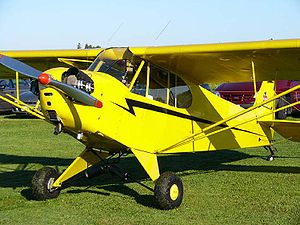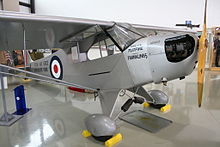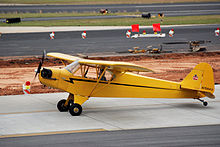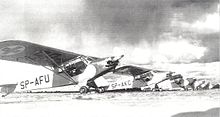- Piper J-3 Cub
-
J-3 Cub Piper J-3 Cub Role Trainer Manufacturer Piper Designer C. G. Taylor
Walter JamouneauFirst flight 1938 Produced 1938-1947 Number built 19,888 (US built)[1]
150 (Canadian-built)[1]
253 TG-8 gliders[1]Unit cost $995-$2,461 when new Variants PA-15 Vagabond
PA-16 Clipper
PA-18 Super CubThe Piper J-3 Cub is a small, simple, light aircraft that was built between 1937 and 1947 by Piper Aircraft. With tandem (fore and aft) seating, it was intended for flight training but became one of the most popular and best-known light aircraft of all time. The Cub's simplicity, affordability and popularity invokes comparisons to the Ford Model T automobile.
The aircraft's standard chrome yellow paint has come to be known as “Cub Yellow” or "Lock Haven Yellow".[2]
Contents
Pre-war
The Taylor E-2 Cub first appeared in 1930, built by Taylor Aircraft in Bradford, Pennsylvania. Sponsored by William T. Piper, a Bradford industrialist who had invested in the company, the E-2 was meant to be an affordable aircraft that would encourage interest in aviation. Later in 1930, the company went bankrupt, with Piper buying the assets but keeping founder C. Gilbert Taylor on as president. In 1936, an earlier Cub was altered by employee Walter Jamouneau to become the J-2 while Taylor was on sick leave. (The coincidence led some to believe that the "J" stood for Jamouneau, while aviation historian Peter Bowers concluded that the letter simply followed the E, F, G, and H models, with the I omitted because it could be mistaken for the numeral one.).[3][4] When he saw the redesign, Taylor was so incensed that he fired Jamouneau. Piper, however, had encouraged Jamouneau's changes, and hired him back. Piper then bought Taylor's share in the company, paying him US$250 per month for three years. [5]
Although sales were initially slow, about 1,200 J-2s were produced before a fire in the Piper factory ended its production in 1938. After Piper moved his company from Bradford to Lock Haven, the J-3, which featured further changes by Jamouneau, replaced the J-2. The changes mostly amounted to integrating the vertical fin of the tail into the rear fuselage structure and covering it simultaneously with the fuselage, changing the rearmost side window's shape to a smoothly curved half-oval outline, and placing a true steerable tailwheel at the rear end of the J-2's leaf spring-style tailskid, linked for its steering function to the lower end of the rudder with springs and lightweight chains to either end of a double-ended rudder control horn. Powered by a 40 hp (30 kW) engine, in 1938, it sold for just over $1,000.[6]
A number of different air-cooled engines, most of flat-four configuration, were used to power J-3 Cubs, resulting in differing model designations for each type: the J3C models used the Continental A series,[7] the J3F used the Franklin 4AC,[8] and the J3L used the Lycoming O-145.[9] A very few examples, designated J3P, were equipped with Lenape Papoose 3-cylinder radial engines.[10]
The outbreak of hostilities in Europe in 1939, coupled with the growing realization that the United States might soon be drawn into World War II, resulted in the formation of the Civilian Pilot Training Program (CPTP). The Piper J-3 Cub became the primary trainer aircraft of the CPTP and played an integral role in its success, achieving legendary status. 75 percent of all new pilots in the CPTP (from a total of 435,165 graduates) were trained in Cubs. By war's end, 80 percent of all United States military pilots had received their initial flight training in Piper Cubs.[11]
The need for new pilots created an insatiable appetite for the Cub. In 1940, the year before the United States' entry into the war, 3,016 Cubs had been built; wartime demands soon increased that production rate to one Cub being built every 20 minutes.[11]
Flitfire
Prior to the United States entering World War II, J-3s were part of a fund-raising programs to support the United Kingdom. Billed as a Flitfire, a Piper Cub J3 bearing Royal Air Force insignia was donated by W. T. Piper and Franklin Motors to the RAF Benevolent Fund to be raffled off. Piper distributors nationwide were encouraged to do the same. On April 29, 1941 all 49 Flitfire aircraft, one for DC and one for each of the 48 US states, flew into La Guardia Field for a dedication and fundraising event which included Royal Navy officers from the battleship HMS Malaya, in New York for repairs, as honored guests.[12][13] At least three of the original Flitfires are known to exist in the 21st century - one, on display and restored to its original silver-doped finish, powered with a Franklin 65 engine it is on display at the North Carolina Aviation Museum in Asheboro, North Carolina. This Flitfire was flown by Orville Wright in a war bond promotion campaign.[14]
World War II service
The Piper Cub quickly became a familiar sight. First Lady Eleanor Roosevelt took a flight in a J-3 Cub, posing for a series of publicity photos to help promote the CPTP. Newsreels and newspapers of the era often featured images of wartime leaders, such as Generals Dwight Eisenhower, George Patton and George Marshall, flying around European battlefields in Piper Cubs. Civilian-owned Cubs joined the war effort as part of the newly formed Civil Air Patrol (CAP), patrolling the Eastern Seaboard and Gulf Coast in a constant search for German U-boats and survivors of U-boat attacks.[citation needed]
Piper developed a military variant ("All we had to do," Bill Jr. is quoted as saying, "was paint the Cub olive drab to produce a military airplane"),[5] variously designated as the O-59 (1941), L-4 (after April 1942), and NE (U.S. Navy). The L-4 Grasshopper was mechanically identical to the J-3 civilian Cub, but was distinguishable by the use of a Plexiglas greenhouse skylight and rear windows for improved visibility, much like the Taylorcraft L-2 and Aeronca L-3 also in use with the US armed forces. Carrying a single pilot and no passenger, the L-4 had a top speed of 85 mph (137 km/h), a cruise speed of 75 mph (121 km/h), a service ceiling of 12,000 ft (3,658 m), a stall speed of 38 mph (61 km/h), an endurance of three hours[15], and a range of 225 mi (362 km).[16] 5,413 L-4s were produced for U.S. forces, including 250 built for the U.S. Navy under contract as the NE-1 and NE-2.[17][18]
All L-4 models, as well as similar, tandem-cockpit accommodation aircraft from Aeronca and Taylorcraft, were collectively nicknamed “Grasshoppers”, though the L-4 was almost universally referred to by its civilian designation of Cub. The L-4 was used extensively in World War II for reconnaissance, transporting supplies, artillery spotting duties, and medical evacuation of wounded soldiers.[11] During the Allied invasion of France in June 1944, the L-4's slow cruising speed and low-level manueverability made it an ideal observation platform for spotting hidden German tanks waiting in ambush in the hedgerowed bocage country south of the invasion beaches. For these operations the pilot generally carried both an observer/radio operator and a 25-pound communications radio, a load that often exceeded the plane's specified weight capacity.[15] After the Allied breakout in France, L-4s were also sometimes equipped with improvised racks of infantry bazookas for ground attack against German armored units. The most famous of these L-4 ground attack planes was Rosie the Rocketeer, piloted by Maj. Charles "Bazooka Charlie" Carpenter, whose six bazooka rocket launchers were credited with eliminating six enemy tanks and several armored cars during its wartime service.[19][20]
After the war, many L-4s were sold as surplus, but a considerable number were retained in service.[21] L-4s sold as surplus in the U.S. were redesignated as J-3s, but often retained their wartime glazing and paint.[22]
Postwar
Polish L-4 Cubs in 1951, used in the air ambulance role.
An icon of the era, and of American general aviation in general, the J-3 Cub has long been loved by pilots and non-pilots alike, with thousands still in use today. Piper sold 19,073 J-3s between 1938 and 1947, the majority of them L-4s and other military variants. Postwar, thousands of Grasshoppers were civilian-registered under the designation J-3. Hundreds of Cubs were assembled from parts in Canada (by Cub Aircraft as the Cub Prospector), Denmark and Argentina, and by a licensee in Oklahoma.
In the late 1940s, the J-3 was replaced by the Piper PA-11 Cub Special (1,500 produced), the first Piper Cub version to have a fully enclosed cowling for its powerplant, and then the Piper PA-18 Super Cub, which Piper produced until 1981 when it sold the rights to WTA Inc. In all, Piper produced 2,650 Super Cubs. The Super Cub had a 150 hp (110 kW) engine which increased its top speed to 130 mph (210 km/h); its range was 460 miles (740 km).
Korean War Service
The L-4 was used extensively by both U.S. and South Korean Air Forces in the early 1950s.[21] During the Korean War, the L-4 saw service in many of the same roles it had performed during World War II, such as artillery spotting, forward air control, and reconnaissance.[21] Some L-4s were fitted with a high-back canopy in order to carry a single stretcher for medical evacuation of wounded soldiers.[21]
Modern J-3 Cub Production
Modernized and up-engined versions are produced today by Cub Crafters of Washington and by American Legend Aircraft in Texas, as the Cub continues to be sought after by bush pilots for its STOL capabilities, as well as by recreational pilots for its nostalgia appeal. The new aircraft are actually modeled on the PA-11, though the Legend company does sell an open-cowl version with the cylinder heads exposed, like the J-3 Cub. An electrical system is standard from both manufacturers.
So popular is the J-3 as a subject for radio controlled model aircraft that manufacturers of R/C heat shrinkable iron-on covering film and similar fabric coverings produce it in a readily available Cub Yellow hue.
The J-3 is distinguished from its successors by having a cowl that exposes its engine's cylinder heads. There are very few other examples of "flat" aircraft engine installations (as opposed to radial engines) in which the cylinder heads are exposed. From the PA-11 on through the present Super Cub models, the cowling surrounds the cylinder heads.
A curiosity of the J-3 is that when it is flown solo, the lone pilot normally occupies the rear seat for proper balance, to balance the fuel tank located at the firewall. Starting with the PA-11, and some L-4s, fuel was carried in wing tanks, allowing the pilot to fly solo from the front seat.
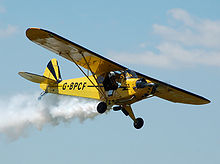 Piper J3C-65 displays at Cotswold Airport, Gloucestershire, England in 2010. This aircraft is part of O’Briens Flying Circus Aerobatic Stunt Team.
Piper J3C-65 displays at Cotswold Airport, Gloucestershire, England in 2010. This aircraft is part of O’Briens Flying Circus Aerobatic Stunt Team.
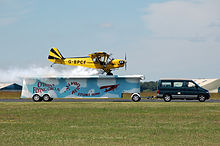 Piper J3C-65 lands on a moving trailer at Cotswold Airport, Gloucestershire, England, in 2010. This aircraft is shown in closeup above.
Piper J3C-65 lands on a moving trailer at Cotswold Airport, Gloucestershire, England, in 2010. This aircraft is shown in closeup above.
Variants
Civil variants
- J-3
- Equipped with a Continental A-40, A-40-2 or A-40-3 engine of 37 hp (28 kW), or A-40-4 engine of 40 hp (30 kW)[23]
- J3C-40
- Certified 14 July 1938 and equipped with a Continental A-40-4 or A-40-5 of 40 hp (30 kW)[7]
- J3C-50
- Certified 14 July 1938 and equipped with a Continental A-50-1 or A-40-2 to -9 (inclusive) of 50 hp (37 kW)[7]
- J3C-50S
- Certified 14 July 1938 and equipped with a Continental A-50-1 or A-40-2 to -9 (inclusive) of 50 hp (37 kW). Equipped with optional float kit.[7]
- J3C-65
- Certified 6 July 1939 and equipped with a Continental A-65-1 or A-65-3, 6, 7, 8, 8F, 9 or 14 of 65 hp (48 kW) or an A-65-14, Continental A-75-8, A-75-8-9 or A-75-12 of 75 hp (56 kW) or Continental A-85-8 or C-85-12 of 85 hp (63 kW) or Continental A-90-8F of 90 hp (67 kW)[7]
- J3C-65S
- Certified 27 May 1940 and equipped with a Continental A-65-1 or A-65-3, 6, 7, 8, 8F, 9 or 14 of 65 hp (48 kW) or an A-65-14, Continental A-75-8, A-75-8-9 or A-75-12 of 75 hp (56 kW) or Continental A-85-8 or C-85-12 of 85 hp (63 kW) or Continental A-90-8F of 90 hp (67 kW). Equipped with optional float kit.[7]
- J3F-50
- Certified 14 July 1938 and equipped with a Franklin 4AC-150 Series 50 of 50 hp (37 kW)[8]
- J3F-50S
- Certified 14 July 1938 and equipped with a Franklin 4AC-150 Series 50 of 50 hp (37 kW). Equipped with optional float kit.[8]
- J3F-60
- Certified 13 April 1940 and equipped with a Franklin 4AC-150 Series A of 65 hp (48 kW) or a Franklin 4AC-171 of 60 hp (45 kW).[8]
- J3F-60S
- Certified 31 May 1940 and equipped with a Franklin 4AC-150 Series A of 65 hp (48 kW) or a Franklin 4AC-171 of 60 hp (45 kW). Equipped with optional float kit.[8]
- J3F-65
- Certified 7 August 1940 and equipped with a Franklin 4AC-176-B2 or a Franklin 4AC-176-BA2 of 65 hp (48 kW).[8]
- J3F-65S
- Certified 4 January 1943 and equipped with a Franklin 4AC-176-B2 or a Franklin 4AC-176-BA2 of 65 hp (48 kW). Equipped with optional float kit.[8]
- J3L
- Certified 17 September 1938 and equipped with a Lycoming O-145-A1 of 50 hp (37 kW) or a Lycoming O-145-A2 or A3 of 55 hp (41 kW)[9]
- J3L-S
- Certified 2 May 1939 and equipped with a Lycoming O-145-A1 of 50 hp (37 kW) or a Lycoming O-145-A2 or A3 of 55 hp (41 kW). Equipped with optional float kit.[9]
- J3L-65
- Certified 27 May 1940 and equipped with a Lycoming O-145-B1, B2 or B3 of 65 hp (48 kW)[9]
- J3L-65S
- Certified 27 May 1940 and equipped with a Lycoming O-145-B1, B2 or B3 of 65 hp (48 kW). Equipped with optional float kit.[9]
- J3P
- Variant powered by a 50 hp (37 kW) Lenape LM-3-50 or Lenape AR-3-160 engine.[1][10]
- J-3R
- Variant with slotted flaps powered by a 65 hp (48 kW) Lenape LM-3-65 engine.[1]
- J-3X
- 1944 variant with cantilever wing powered by a 65 hp (48 kW) Continental A-65-8 engine.[1]
- Cammandre 1
- A French conversion of J-3 Cub/L-4 aircraft.[24]
Military designations and variants
- YO-59
- Test and evaluation aircraft. Four Piper J3C-65s were sold to the US Army Air Corps for evaluation.[25]
- O-59
- Production two-seat observation, liaison aircraft for the USAAC; 140 built later re-designated L-4.[25]
- O-59A
- Improved version, powered by a 65-hp (48-kW) Continental O-170-3 piston engine; 948 built, later re-designated L-4A.[25]
- L-4
- Resignation of the YO-59 and O-59.[26]
- L-4A
- Redesignation of the O-59A.[26]
- L-4B
- Similar to the L-4A, but without radio equipment; 980 built.[26]
- L-4C
- Eight impressed J3L-65s, first two originally designated UC-83A.[26]
- L-4D
- Five impressed J3F-65s.[26]
- L-4H
- Similar to the L-4B but with equipment improved and fixed-pitch propeller, 1801 built.[26]
- L-4J
- Same as the L-4H but with controllable-pitch propeller, 1680 built.[26]
- UC-83A
- Two impressed J3L-65s later re-designated L-4C.[27]
- TG-8
- Three-seat training glider variant, 250 built.[28]
- LNP
- Three TG-8 training glider variant for the United States Navy.[28]
- NE-1
- United States Navy designation for the J3C-65 with dual controls, 230 built.[29]
- NE-2
- Same as NE-1 with minor equipment changes, 20 built.[29]
Operators
Civil operators
The aircraft has been popular with flying schools and remains so with private individuals.
Military operators
- Military of Paraguay - L-4[30]
- South Korean Air Force[31]
- United States Air Force[1]
- United States Army[31]
- United States Army Air Force[1]
- United States Navy[1][31]
Specifications (J3C-65 Cub)
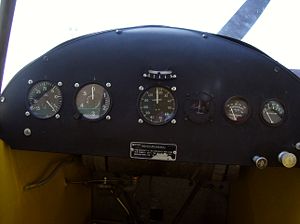 Inside the cockpit of a Piper Cub. The aircraft has far fewer instruments than most modern aircraft.
Inside the cockpit of a Piper Cub. The aircraft has far fewer instruments than most modern aircraft.
Data from The Piper Cub Story[33]
General characteristics
- Crew: one pilot
- Capacity: one passenger
- Length: 22 ft 5 in (6.83 m)
- Wingspan: 35 ft 3 in (10.74 m)
- Height: 6 ft 8 in (2.03 m)
- Wing area: 178.5 ft² (16.58 m²)
- Empty weight: 765 lb (345 kg)
- Useful load: 455 lb (205 kg)
- Max takeoff weight: 1,220 lb (550 kg)
- Powerplant: 1 × Continental A-65-8 air-cooled flat four, 65 hp (48 kW) at 2,350 rpm
Performance
- Maximum speed: 76 kn (87 mph, 140 km/h)
- Cruise speed: 65 kn (75 mph, 121 km/h)
- Range: 191 NM (220 mi, 354 km)
- Service ceiling: 11,500 ft (3,500 m)
- Rate of climb: 450 ft/min (2.3 m/s)
- Wing loading: 6.84 lb/ft² (33.4 kg/m²)
- Power/mass: 18.75 lb/hp (11.35 kg/kW)
See also
- Related development
- Piper J-2
- Piper PA-15 Vagabond
- Piper PA-16 Clipper
- Piper PA-20 Pacer
- Piper PA-18 Super Cub
- CubCrafters CC11-100 Sport Cub S2
- Wag-Aero CUBy
- Wag-Aero Sport Trainer
- LIPNUR Belalang
- Aircraft of comparable role, configuration and era
- Aeronca Champ
- Fieseler Fi 156 Storch
- Kitfox Model 5
- Taylorcraft BC-65
- Taylorcraft L-2
- Aeronca L-3
References
- ^ a b c d e f g h i Peperell 1987, pp. 22-34
- ^ Lord, Magnus (April 2008). "The story of Cub Yellow". http://www.pipercubforum.com/yellow.htm. Retrieved 2008-09-15.
- ^ "Piper J-3". Aircraft of the Smithsonian. http://www.nasm.si.edu/research/aero/aircraft/piperj3.htm. Retrieved 2006-04-02.
- ^ Peter M. Bowers, Piper Cubs (Tab Books 1993)
- ^ a b Spence, Charles (23 September 1997). "They're not all Piper Cubs". Aviation History. http://www.historynet.com/theyre-not-all-piper-cubs-november-97-aviation-history-feature.htm. Retrieved 2011-09-06.
- ^ Piper J-3 Cub Film Series (TM Technologies, footage from 1937-1948 shows step-by-step construction. 110 minutes.)
- ^ a b c d e f Federal Aviation Administration (August 2006). "AIRCRAFT SPECIFICATION NO. A-691". http://www.airweb.faa.gov/Regulatory_and_Guidance_Library/rgMakeModel.nsf/0/f323caa28762f4c486257209007258d4/$FILE/A-691.pdf. Retrieved 2010-02-15.
- ^ a b c d e f g Federal Aviation Administration (August 2006). "AIRCRAFT SPECIFICATION NO. A-692". http://www.airweb.faa.gov/Regulatory_and_Guidance_Library/rgMakeModel.nsf/0/b517fb092ee72c198625720a0055b58a/$FILE/A-692.pdf. Retrieved 2010-02-15.
- ^ a b c d e Federal Aviation Administration (August 2006). "AIRCRAFT SPECIFICATION A-698". http://www.airweb.faa.gov/Regulatory_and_Guidance_Library/rgMakeModel.nsf/0/654cec2e0f108d0a8625720900728d14/$FILE/a-698.pdf. Retrieved 2010-02-15.
- ^ a b Federal Aviation Administration (October 1942). "Approved Type Certificate 695". http://www.airweb.faa.gov/Regulatory_and_Guidance_Library/rgMakeModel.nsf/0/ae0aecbca42009eb862572c9006edb1b/$FILE/ATTYNRM6/TC695.pdf. Retrieved 2010-02-18.
- ^ a b c Guillemette, Roger. "The Piper Cub". US Centennial of Flight Commission. http://www.centennialofflight.gov/essay/GENERAL_AVIATION/piper/GA6.htm. Retrieved 2006-04-02.
- ^ "Shindig at N.Y. Airport Opens Fund Drive for R.A.F.". Life. 12 May 1941. http://books.google.com/books?id=sUwEAAAAMBAJ&pg=PA36&dq=flitfire&hl=en&ei=JmmCTIrlMML38Aa11YX0AQ&sa=X&oi=book_result&ct=result&resnum=5&ved=0CDUQ6AEwBA#v=onepage&q=flitfire&f=false.
- ^ "Alamo Liaison Squadron". http://www.als-cannonfield.com/Flitfire.htm.
- ^ "Museum Guide". North Carolina Aviation Museum.
- ^ a b Fountain, Paul, The Maytag Messerschmitts, Flying Magazine, March 1945, p. 90: With one pilot aboard, the L-4 had a maximum endurance of three hours' flight time (no reserve) at a reduced cruising speed of 65 mph.
- ^ Gunston, Bill, and Bridgman, Leonard, Jane's Fighting Aircraft of World War II, Studio Editions, ISBN 1851701990, 9781851701995 (1989), p. 253
- ^ Frédriksen, John C., Warbirds: An Illustrated guide to U.S. Military Aircraft, 1915-2000, ABC-CLIO, ISBN 1576071316, 9781576071311 (1999), p. 270
- ^ Bishop, Chris, The Encyclopedia of Weapons of World War II, Sterling Publishing Company, Inc., ISBN 1586637622, 9781586637620 (2002), p. 431
- ^ What's New in Aviation: Piper Cub Tank Buster, Popular Science, Vol. 146 No. 2 (February 1945) p. 84
- ^ Kerns, Raymond C., Above the Thunder: Reminiscences of a Field Artillery Pilot in World War II, Kent State University Press, ISBN 9780873389808, 0873389808 (2009), pp. 23-24, 293-294
- ^ a b c d Edwards, Paul M., Korean War Almanac, Infobase Publishing, ISBN 0816060371, 9780816060375 (2006), p. 502
- ^ Nicholas Aircraft Sales, Flying Magazine, April 1946, Vol. 38, No. 4, ISSN 0015-4806, p. 106
- ^ Federal Aviation Administration (October 1939). "Approved Type Certificate 660". http://www.airweb.faa.gov/Regulatory_and_Guidance_Library/rgMakeModel.nsf/0/9ae985fe2a4d8847862572c9006eda41/$FILE/ATTQ7W2D/ATC660.pdf. Retrieved 2010-02-15.
- ^ "Cammandre 1". http://www.abpic.co.uk/search.php?q=Camandre%201%20(Cub%20conversion)&u=type. Retrieved 2011-02-07.
- ^ a b c Andrade 1979, p. 140
- ^ a b c d e f g Andrade 1979, p. 129
- ^ Andrade 1979, p. 81
- ^ a b Andrade 1979, p. 170
- ^ a b Andrade 1979, p. 201
- ^ Krivinyi, Nikolaus: World Military Aviation, page 181. Arco Publishing Company, 1977. ISBN 0-668-04348-2
- ^ a b c Triggs, James M.: The Piper Cub Story, pages 13-19. The Sports Car Press, 1963. SBN 87112-006-2
- ^ Andrade 1979, p. 239
- ^ Triggs, James M.: The Piper Cub Story, page 31. The Sports Car Press, 1963. SBN 87112-006-2
- Andrade, John (1979). U.S.Military Aircraft Designations and Serials since 1909. Midland Counties Publications. ISBN ISBN 0 904597 22 9.
- Bowers, Peter M. (1993). Piper Cubs. McGraw Hill. ISBN 0-8306-2170-9.
- Peperell, Roger W; Smith, Colin M (1987). Piper Aircraft and their Forerunners. Tonbridge, Kent, England: Air-Britain. ISBN 0 85130 149 5.
External links
- Fixed Wing Piper at the Open Directory Project
- Fiddler's Green history of the J-3
- The New Piper Aircraft, Inc. - Heritage - Brief timeline of the history of Piper Aircraft Company, starting with the Piper Cub
- Sentimental Journey - Annual fly-in of Piper Cubs held in Lock Haven, Pennsylvania
- T.O. No. 01-140DA-1 Pilot's Flight Instructions L-4A and L-4B Airplanes (1943)
- 01-140DA-2 Erection and Maintenance Instructions for Airplanes Army Models L-4A, L-4B, L-4H, and L-4J British Model Piper Cub (1945)
Piper aircraft Civilian E-2 · F-2 · G-2 · H-2 · J-2 · J-3 · J-4 · J-5 · PA-6 · PA-7 · PA-8 · PA-11 · PA-12 · PA-14 · PA-15 · PA-16 · PA-17 · PA-18 · PA-19 · PA-20 · PA-22 · PA-23 · PA-24 · PA-25 · PA-26 · PA-28 · PA-29 · PA-30 · PA-31 · PA-31T · PA-32 · PA-32R · PA-33 · PA-34 · PA-35 · PA-36 · PA-38 · PA-39 · PA-40 · PA-41 · PA-42 · PA-44 · PA-46 · PA-47 · PA-60 · PiperSport · PT-1 · PWA-1 · PWA-6 · PWA-8
Military USN/USMC trainer aircraft designations 1922-1948 Boeing NB • N2B
Curtiss (NC not assigned) • N2C
Piper Huff-Daland Howard North American Keystone Langley Martin (NM not assigned) • N2M
Naval Aircraft Factory Spartan NP
Fairchild Ryan Stearman New Standard Timm Consolidated USAAF/USAF liaison aircraft USAAC/USAAF observation aircraft Observation O-1 • O-2 • XO-3 • XO-4 • O-5 • O-6 • O-7 • O-8 • O-9 • XO-10 • O-11 • O-12 • O-14 • XO-14 • XO-15 • XO-16 • O-17 • XO-18 • O-19 • YO-20 • XO-21 • O-22 • YO-23 • O-24 • O-25 • Y1O-26 • Y1O-27 • O-28 • O-29 • O-30 • O-31 • O-32 • Y1O-33 • O-34 • O-35 • XO-36 • O-37 • O-38 • O-39 • O-40 • Y1O-41 • O-42 • O-43 • XO-44 • O-45 • O-46 • O-47 • XO-48 • O-49 • YO-50 • YO-51 • O-52 • O-53 • YO-54 • YO-55 • O-56 • O-57 • O-58 • O-59 • O-60 • XO-61 • O-62 • XO-63
Observation Amphibian USAAS/USAAC/USAAF/USAF transport designations 1925–1962, 2005-2006 Main sequence
1925-1962C-1 • C-2 • C-3 • C-4 • C-5 • C-6 • C-7 • C-8 • C-9 • XC-10 • Y1C-11 • Y1C-12 • C-13 (Not assigned) • C-14 • C-15 • C-16 • Y1C-17 • C-18 • C-19 • C-20 • C-21 • Y1C-22 • Y1C-23 • Y1C-24 • Y1C-25 • C-26 • C-27 • C-28 • C-29 • YC-30 • C-31 • C-32 • C-33 • C-34 • XC-35 • C-36 • C-37 • C-38 • C-39 • C-40 • C-41/A • C-42 • UC-43 • C-44 • C-45 • C-46 • C-47 • C-48 • C-49 • C-50 • C-51 • C-52 • C-53 • C-54 • C-55 • C-56 • C-57 • C-58 • C-59 • C-60 • UC-61 • C-62 • C-63 • C-64 • C-65 • C-66 • UC-67 • C-68 • C-69 • UC-70/A/B/C/D • UC-71 • UC-72 • C-73 • C-74 • C-75 • C-76 • UC-77 • C-78 • C-79 • C-80 • UC-81 • C-82 • C-83 • C-84 • UC-85 • C-86 • C-87 • C-88 • C-89 • C-90 • C-91 • UC-92 • C-93 • UC-94 • UC-95 • UC-96 • KC-/C-97 • C-98 • XC-99 • UC-100 • UC-101 • C-102 • UC-103 • C-104 • C-105 • C-106 • C-107 • C-108 • C-109 • C-110 • C-111 • XC-112 • XC-113 • XC-114 • XC-115 • XC-116 • C-117 • C-118 • C-119 • XC-120 • C-121/F • YC-122 • C-123/A • C-124 • YC-125 • LC-126 • C-127 (I) • C-127 (II) • C-128 • YC-129 • C-130 • C-131 • C-132 • C-133 • YC-134 • KC-/C-135 • C-136 • C-137 • C-138 (Not assigned) • C-139 (Not assigned) • C-140 • C-141 • XC-142
Revived sequence
2005-2006C-143 • C-144
See also: Post-1962 listUSAAC/USAAF glider aircraft designations Assault Glider AG-1 • AG-2
Bomb Glider Cargo Glider Fuel Glider Powered Glider Training Glider Lists relating to aviation General Aircraft (manufacturers) · Aircraft engines (manufacturers) · Airlines (defunct) · Airports · Civil authorities · Museums · Registration prefixes · Rotorcraft (manufacturers) · TimelineMilitary Accidents/incidents Records Categories:- High wing aircraft
- Single-engine aircraft
- Propeller aircraft
- Piper aircraft
- United States civil utility aircraft 1930–1939
- United States military utility aircraft 1940–1949
Wikimedia Foundation. 2010.

